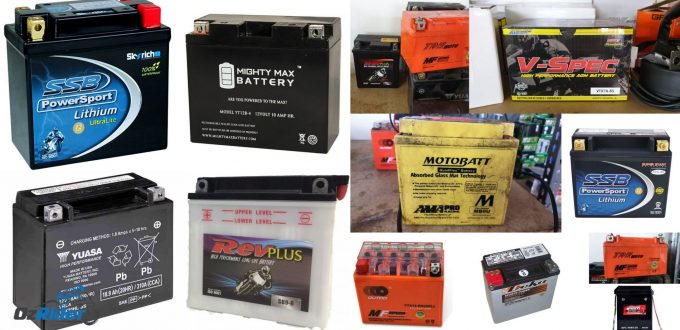There is one component in our motorbikes which many of us don’t spend much time thinking about. The battery.
The battery is just there. Doing its job reliably, starting the bike, powering our light, indicators and accessories. Normally we don’t have to worry about it, unless it reaches its old age and needs replacing. Or if the bike was left for too long without riding (but this is a topic for a different article).
Types of batteries
There are four main types of motorcycle batteries: Lead-Acid (LA), Absorbed Glass Mat (AGM), Gel Cell and Lithium-Ion (LI).
Lead-Acid Batteries (LA)
Lead-Acid is the conventional motorcycle battery, also known as Wet Cell or Flooded Cell battery. The battery cells electrolytes are held in a liquid acid. It requires maintenance, which includes periodic checks of the water level and top up with distilled water. As the battery is not sealed care must be taken to avoid spillage.
AGM Batteries
AGM batteries are also known as Sealed Batteries or Dry Cells. They are the most popular and widely-used batteries on new bikes.
Unlike LA batteries, once AGM batteries are filled, they do not need to be topped-up or the acid level checked.
AGM batteries recharge faster than LA batteries and are more resilient to deep discharge. However, they are sensitive to overcharge and can be affected by heat.
Gel Cell Batteries
Gel Cell batteries are also sealed and maintenance free. In Gel batteries the electrolyte is suspended in silica-type gel.
Gel batteries have a longer lifespan than LA and AGM batteries. They maintain high performance until they reach end-of-life, at which point their performance simply drops. There’s no degradation over time. In addition, they are sensitive to overcharging.
Lithium-Ion Batteries
LI batteries are small and light. Although they are more expensive than the other types, they have the longest life span of all types mentioned. LI have a slow self-discharge rate and maintain their voltage quite well. However, LI batteries cannot use standard battery chargers and require special chargers.
Which is the better battery for me?
As it is often the case, the answer is “depends”… depends on what you need.
When choosing a new battery we need to consider lifespan, maintenance, size, weight, self-discharge rate, temperature tolerance and of course price.
We all have different priorities and requirements.
If weight is your highest concern and every gram counts, then the LI battery should be your first choice. LI batteries are considerably smaller and lighter. However, they don’t work at their best in cold temperatures and need to be warm in order to work properly. In addition, LI batteries are pricier than LA and AGM batteries.
The Gel battery is a good option when LI battery price is too high but performance is still a priority. Apart from their higher capacity and slow self-discharge time, Gel batteries have high lifespan, require no maintenance, are spill-proof, and can be mounted in any position.
If slow-discharge is your priority because your bike sits idle for long periods, you need to look at LI or Gel batteries as their self-discharge time is slower than LA and AGM. You also need to go out there and ride.
Battery Maintenance
There are some basic maintenance actions we can take in order to maximize battery life.
- Ensure battery connections are tight. A loose connection can have a severe effect on a modern motorcycle
- Check the terminals in LA batteries are clean and free of corrosion
- Ensure water level in LA batteries does not fall below the minimum
- Maintain charge. Trickle charge if left idle for long periods. In the case of LI batteries, If the voltage drops too low an LI battery can suffer severe damage. LA battery, on the other hand, can often be brought back to life from very low voltage
- In cold weather when the bike is not in use, remove the battery from the bike and store in a warmer place.
Higher Capacity, Faster Charging
As the demand for fast-charging electric vehicles grows, so will advances in battery technology. We will soon see smaller, lighter, higher-capacity batteries with fast charging time and an affordable price.
* * *
Be safe. Enjoy the ride
Related articles:
Ultra Fast Charging: Fast Approaching?
Electric Motorcycles Are The Future. But Are We There Yet?


No special charger, I replaced my original battery to Lithium-Ion with no further modifications, that was 2 years ago and It’s great
They are talking about 240v chargers not the alternator charge from your bike